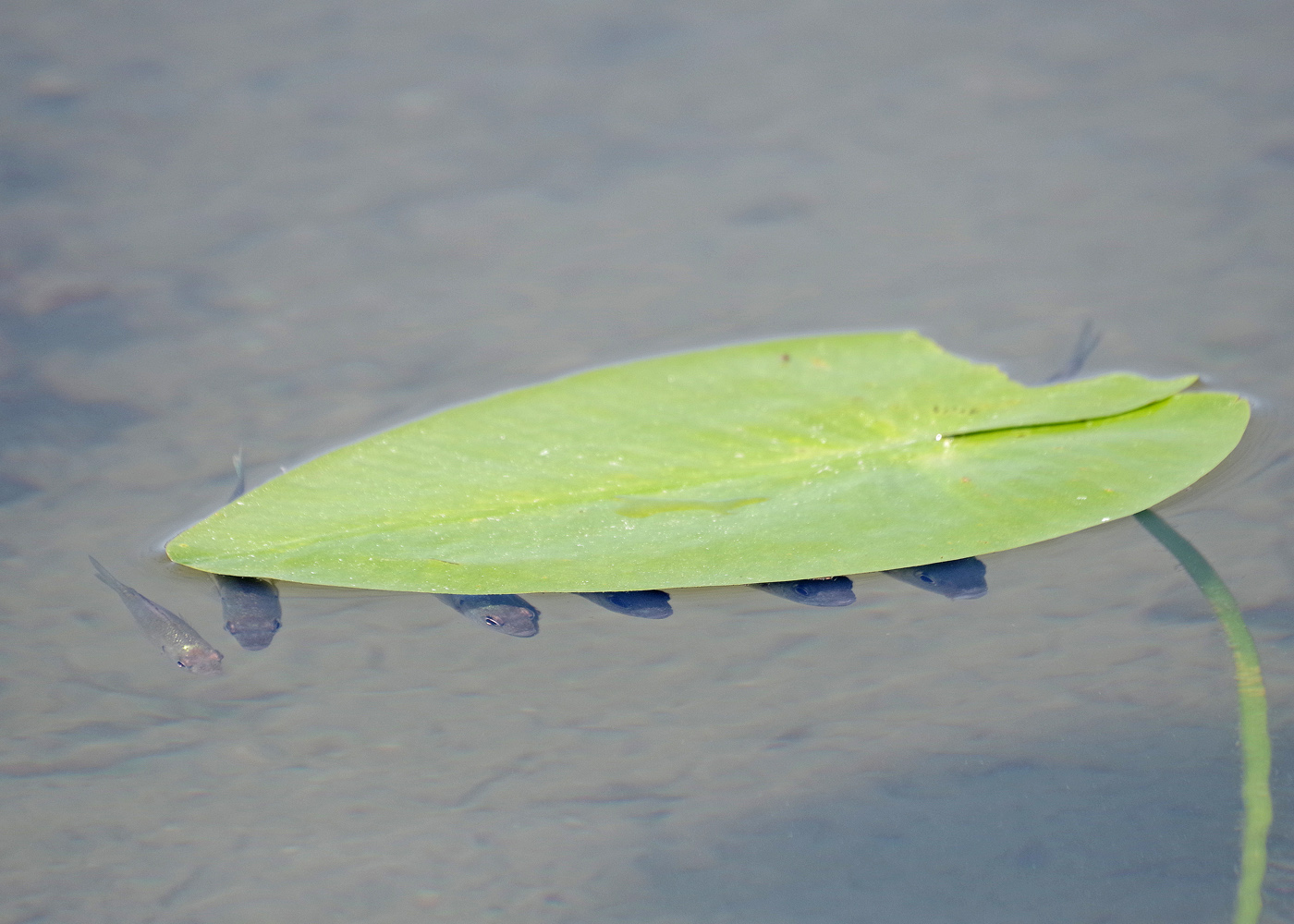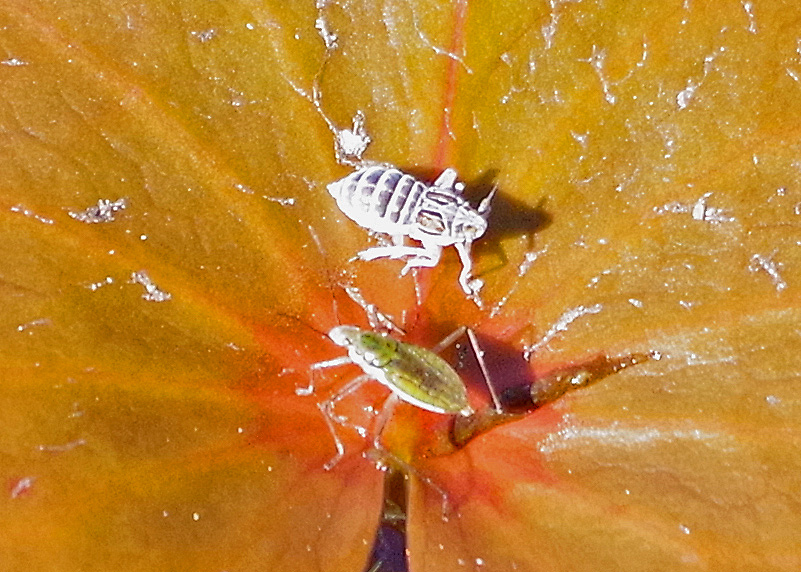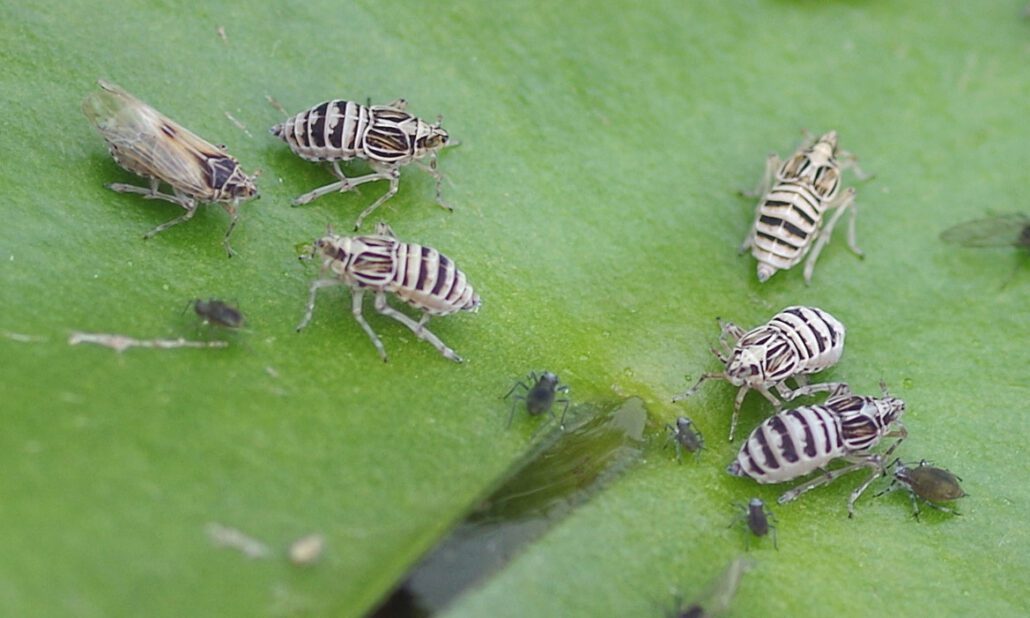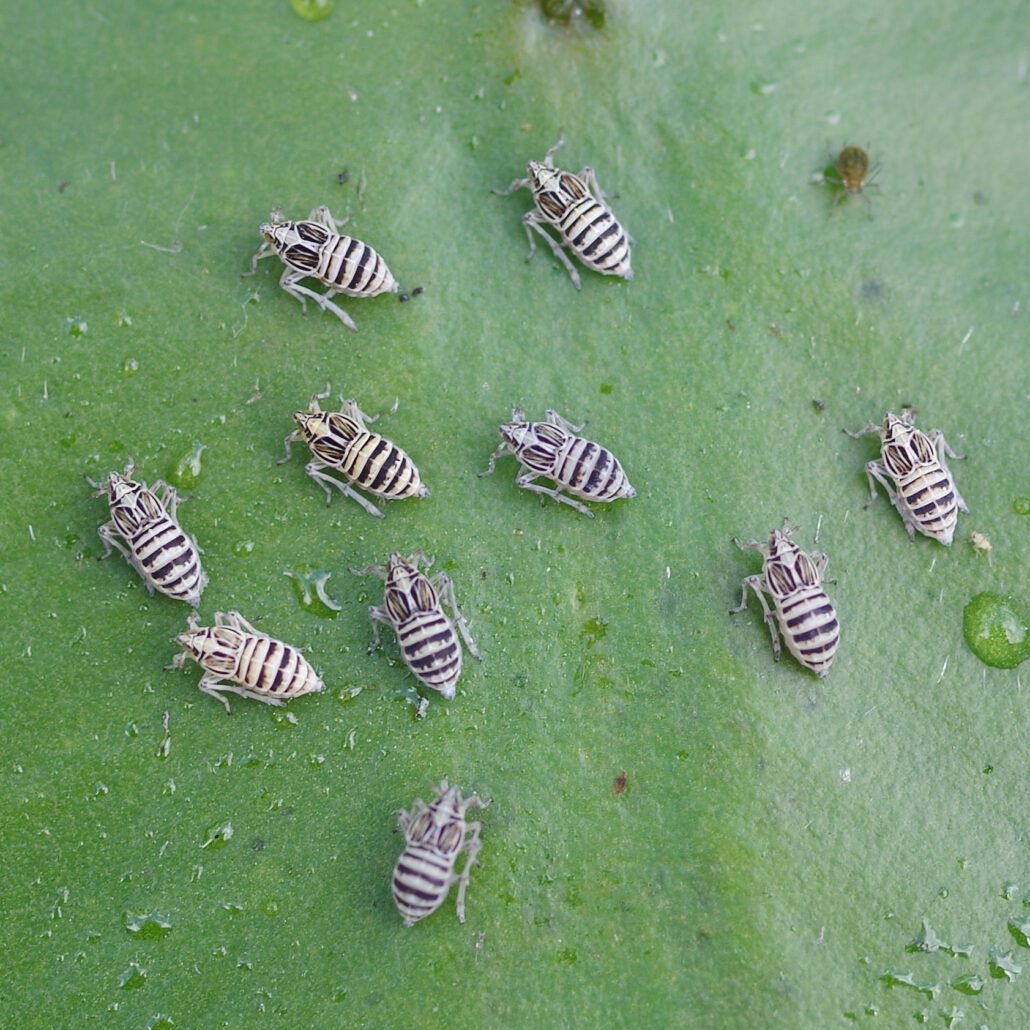
by Kate Redmond
Wetlands Month II Common Water lily Planthopper revised
Salutations BugFans,
Week 2 of National Wetlands Month features an upgrade of an episode that first appeared in March of 2014.
Water lilies are important plants in aquatic ecosystems. At the very least, they provide a dry spot for insects (and frogs and others) to perch on – at most, they are hearth and home. Various parts of the plants are eaten by organisms ranging from snails to moose, and the broad leaves modify/shade/cool the aquatic habitat below (the BugLady was tickled to see a few fish hiding under a lily leaf on a very hot day).
A water lily’s leaf and flower stay on the water’s surface instead of being dragged under by the weight of its long stem because the flexible, hollow stalk is divided into a series of air bladders that buoy it up.
A few insect species are serious water lily specialists, living out their days on the plants. Like Lilypad Forktail damselflies, rarely seen away from them, whose connection is so strong that as they sit on a leaf, the tip of their abdomen is bent down touch it. And like Donacia beetles, whose eggs are laid at the base of the lily leaf and whose larvae attach themselves to the underwater parts of the plant, from which they get both food and oxygen, pupating in a silken cocoon that is dry inside because the air bubbles that leaked from the chewed stem and provided oxygen to the larva have blown the water from the cocoon.
The rhizome of yellow water lily was an important medicine and food of Native Americans (they ate the seeds like popcorn, too), but white water lily was used more for medicine. Henry David Thoreau (that silver-tongued romantic) associated the white water lily with young men picking its flowers on their way to church in Concord, and also said that the flower “reminds me of a young country maiden…wholesome as the odor of a cow.” He reported smoking a stem once and said that it was the “most noxious thing I ever smoked.”
The water lily community has many stories to tell, and the BugLady has already written a few of them. Here’s a tale about some awesome little bugs that she met for the first time at Riveredge Nature Center toward the end of July, 2013 (at the time, BugFan Joanne said, “I’m in wetlands all the time, and I’ve never seen these before!” Ditto!). Some of the water lily leaves hosted masses of the planthoppers for a few weeks, but then they disappeared. Despite searching for them every summer since then, it wasn’t until the summer of 2023 that the BugLady finally found another one (one!).



COMMON WATER LILY/POND LILY PLANTHOPPERS (Megamelus davisi), known in more rarefied circles as the Davis’s Megamelus, are in the bug family Delphacidae, the Delphacid Planthoppers. At first, the BugLady thought they were nymphs, because of their short wing pads, but they were adults. Adult CWLPs come in either reduced-winged (brachypterous) or long-winged (macropterous) models https://bugguide.net/node/view/29578/bgimage, and the brachypterous form is more numerous.
CWLPs are found in the eastern half of the US, but the species has made a surprise appearance in Hawaii. They like ponds and extremely slow streams where white water lilies (genus Nymphaea) grow, and they are also found on the unrelated broad-leaved pondweed (Potamogeton natans). Most of their relatives feed on grasses, but CWLPs eat any part of the water lilies or pondweeds that sticks up above the water line. They’re considered pests if you’re trying to propagate young water lilies, but they don’t damage older, established plants. Another species of Megamelus is welcomed as a biological control of water hyacinth in Florida.
Their nymphs are meals for ravenous water treaders (Mesovelia sp. https://bugguide.net/node/view/1940717/bgimage); they’re attacked by a big-headed fly called Pipunculus varius, and their eggs are parasitized by an exceedingly tiny fairy wasp with the lovely name of Polynema ema https://bugguide.net/node/view/342131/bgimage, whose range exactly matches that of the CWLP because it has been introduced to Hawaii to hassle them there. When a fairy wasp lays her egg on a planthopper egg, she “marks” it with her ovipositor so other females will leave it alone, because there isn’t enough food in the egg for two wasp larvae to share. CWLPs are also noted in a website dedicated to “Fly Fishing Entomology,” although duplicating a fish food that is less than a quarter-inch long would take dedication, indeed.
Females puncture water lily leaves, stems, and midribs to insert single eggs, and the plant obligingly produces tissue that covers the hole (the nymph’s eventual exit does leave a lasting scar, though). There are three generations each year, and the fall generation, which outlasts the disintegrating water lily leaves, overwinters as almost mature nymphs in the leaf litter of shoreline plants. When they become active again in late spring, they move out over the water and recolonize the lily leaves.
So, what’s this little critter famous for?
First, members of the family Delphacidae are outfitted with spurs (calcars) of various sizes and shapes on their hind tibias (“shins”), but CWLPs are overachievers – their spurs are described as “large,” “moveable,” and even “paddle-like” flaps complete with sensory hairs https://bugguide.net/node/view/1959085/bgimage. There are any number of guesses about what these flaps do for the CWLP. Are they oars that help CWLPs move across the water to new plants? Are they skates? According to a note in the 1923 “Bulletin of the State Geological and Natural History Survey of Connecticut,” “its large spurs undoubtedly support it when, by a mischance, it lands on the water.” Or, queried the “Bulletin of the Buffalo Society of Natural Sciences” (Vol. 5, 1886–97), “Is not the large, foliaceous spur in this species an adaptation of Nature to enable these insects to leap more readily from the surface of the water, about which they make their home?” [This theory seems to be the current front-runner.]
Second, in the “When we try to pick out anything by itself, we find it hitched to everything else in the Universe” category, consider the planthopper-frog connection that has been documented in New York State. Northern cricket frogs (Acris crepitans) love to eat CWLPs during the summer (they also like aquatic springtails). CWLPs are the primary food of cricket frogs as the frogs prepare for their own fall migrations to wintering sites, too. According to the (terrific) New York State Conservationist magazine, “a single cricket frog might spend several hours on one lily pad, devouring planthoppers as they move by the thousands over a lily pad.”
In a paper called “Species decline in an outwardly healthy habitat,” forensic ecologist Jay Westerveld describes the crash of Northern cricket frog populations over much of New York State. It seems that aerial spraying for Gypsy moths (now renamed Spongy moths) in the 1970’s wiped out entire populations of CWLPs. When cricket frog numbers plummeted, investigators noted that they could find no CWLPs where they had once been plentiful. Since spraying isn’t done over public water supply areas, pockets of cricket frogs remain in some wetlands adjacent to reservoirs. Westervelt makes the point that the CWLP is a habitat specialist, and the Northern cricket frog is a food specialist. Because the majority of CWLPs are wingless, natural recolonization by the species is painfully slow, and the bugs may need to be reintroduced in order for the frog to rebound.
Forensic ecologist – the BugLady is ready for the TV series.
And – PERIODICAL CICADAS – the gift that keeps on giving: https://www.smithsonianmag.com/smart-news/from-dinner-parties-to-restaurants-cicadas-are-landing-in-the-kitchen-180984321/?utm_source=smithsoniandaily&utm_medium=email&utm_campaign=editorial&spMailingID=49735720&spUserID=ODg4Mzc3MzY0MTUyS0&spJobID=2700967876&spReportId=MjcwMDk2Nzg3NgS2.
Kate Redmond, The BugLady
Bug of the Week archives:
http://uwm.edu/field-station/category/bug-of-the-week/
